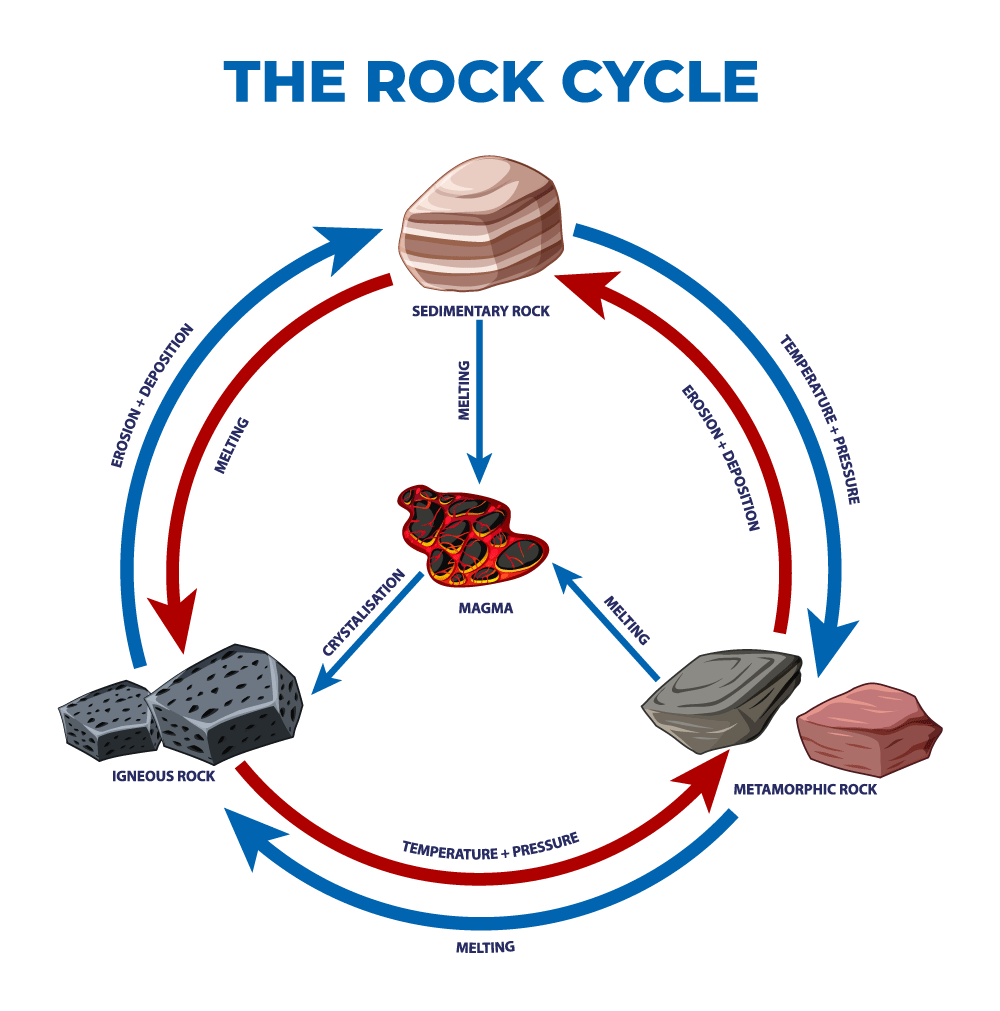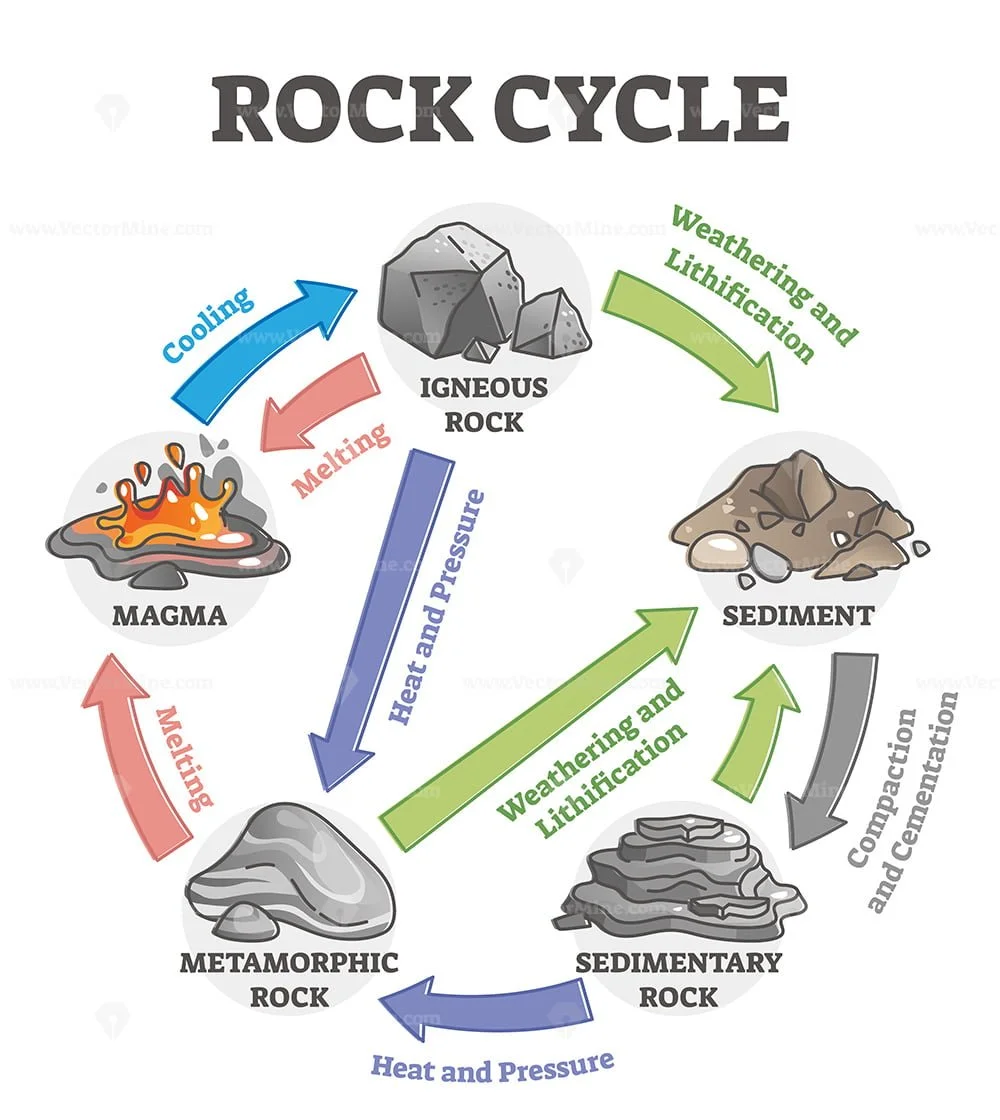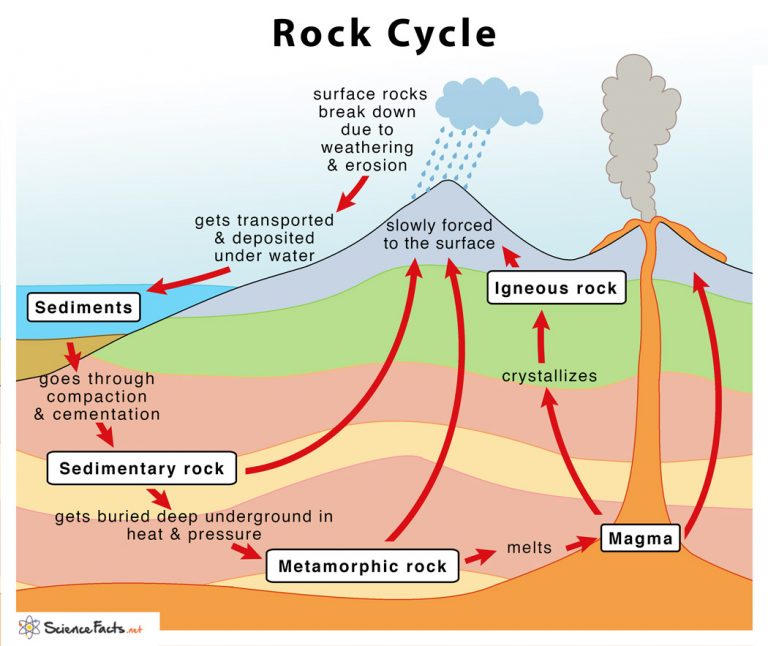Drawing Of A Rock Cycle, Web the rock cycle is driven by two forces:
Drawing Of A Rock Cycle - Web the rock cycle is driven by two forces: (1) earth’s internal heat engine, which moves material around in the core and the mantle and leads to slow but significant changes within the crust, and (2) the sun which powers the hydrological cycle, moving water, wind and air along earth’s surface. Igneous rocks form when magma or lava cools and solidifies. Rocks of any type can be converted into any other type, or into another rock of the same type. Any type of rock can get transformed into any other type. These processes occur over millions of years, but not all the processes happen at the same rate. It involves various geological processes such as weathering, erosion, deposition, compaction, cementation, melting, crystallization, and uplift. Web the rock cycle is explained as a diagram to show best the different conditions that cause rocks to change and how new rocks are formed. Magma that reaches earth’s surface through volcanic activity is called lava. It is occurring continuously in nature through geologic time. The cycle outlines how each rock type can be converted to another rock type through geologic processes. (1) earth’s internal heat engine, which moves material around in the core and the mantle and leads to slow but significant changes within the crust, and (2) the sun which powers the hydrological cycle, moving water, wind and air along earth’s surface. Web. This is a simple explanation of the rock cycle. Web the rock cycle is a concept of geology that describes the transition of rocks between the three rock types: Magma that reaches earth’s surface through volcanic activity is called lava. It is occurring continuously in nature through geologic time. There are three main types of rocks: The rock cycle is driven by energy from earth's interior and the sun. The hydrological cycle is powered by the sun. Web the rock cycle is a natural process that describes how rocks are formed, broken down, and transformed into different types of rocks over time. Igneous, sedimentary and metamorphic, and the simplest diagram of the rock cycle puts these. Web the rock cycle. The cycle outlines how each rock type can be converted to another rock type through geologic processes. We'll walk you through each step of the cycle, and by the end you'll be able to draw a rock cycle diagram like a pro!. Web rock cycle diagram. Earth’s internal heat, which causes material to move around in. When rocks are pushed deep below earth’s surface, they can melt to form magma. This is a simple explanation of the rock cycle. The rock cycle is driven by energy from earth's interior and the sun. Most of us think of rocks as objects which don’t change. The rock cycle picture diagram shows an upper level view of the process. Web the rock cycle describes how rocks on earth form and change over time. Any type of rock can get transformed into any other type. The rock cycle picture diagram shows an upper level view of the process in which these types of rocks will be created or transformed. Use this printable infographic to learn about the rock cycle. The. Web a rock cycle is a fundamental concept that shows the transitions among the three basic rock types (metamorphic, igneous and sedimentary). Web the rock cycle. The rock cycle is driven by two forces: Rocks are broadly classified into three groups: Web a diagram of the rock cycle is a way to explain the formation, or deformation, of the three. Web learn about the rock cycle in geology. The rock cycle is driven by two forces: There are three main types of rocks that appear during the cycle sedimentary, igneous, and metamorphic. Web the rock cycle is the process that describes the gradual transformation between the three main types of rocks: Web the diagram of rock cycle shows the continuous. Igneous rocks form when magma or lava cools and solidifies. Web the rock cycle describes how rocks on earth form and change over time. Rocks of any type can be converted into any other type, or into another rock of the same type. In simple terms, it is a chain of processes that produce and transform the rock types in. The rock cycle is driven by two forces: (1) earth’s internal heat engine, which moves material around in the core and the mantle and leads to slow but significant changes within the crust, and (2) the sun which powers the hydrological cycle, moving water, wind and air along earth’s surface. It involves various geological processes such as weathering, erosion, deposition,. Web rock cycle diagram. Web the processes involved are summarized in the rock cycle (figure 6.3). The cycle outlines how each rock type can be converted to another rock type through geologic processes. Use this printable infographic to learn about the rock cycle. Web the diagram of rock cycle shows the continuous process of transformation of rocks from one form to another over time through geological processes like weathering, erosion, deposition, heat, and pressure. In simple terms, it is a chain of processes that produce and transform the rock types in earth’s crust. Web in this video learn to draw and paint a simple science diagram of rock cycle, it's very easy just watch video till end also click on like, share and commentp. (1) earth’s internal heat engine, which moves material around in the core and the mantle and leads to slow but significant changes within the crust, and (2) the sun which powers the hydrological cycle, moving water, wind and air along earth’s surface. Magma that reaches earth’s surface through volcanic activity is called lava. Web a diagram of the rock cycle is a way to explain the formation, or deformation, of the three types of rocks we find on our earth; Each of these rocks are formed by physical changes—such as melting, cooling, eroding, compacting, or deforming —that are part of the rock cycle. Many of these conditions occur beneath the earth’s surface where we cannot see them,. These changes occur through processes such as melting, solidification, and lithification. Web the rock cycle describes how rocks on earth form and change over time. Igneous rocks form when magma or lava cools and solidifies. Web a rock cycle is a fundamental concept that shows the transitions among the three basic rock types (metamorphic, igneous and sedimentary).
Rock Cycle Drawing imgdandelion

30 Draw And Label The Rock Cycle Labels Database 2020

Rock Cycle Transition, Factors, and Evolving Process

Rock cycle transformation and stone formation process labeled outline

Rock Cycle Diagram How To Draw Rock Cycle Science Diagram YouTube

Rock Cycle Definition, Steps, Importance, Diagram

How to draw Rock cycle diagram drawing with labels very easy way

The Rock Cycle Igneous, Sedimentary and Metamorphic Rocks

Rock Cycle Drawing at GetDrawings Free download

Rock Cycle How Rocks Formed Stock Vector (Royalty Free) 2279798313
It Is Occurring Continuously In Nature Through Geologic Time.
There Are Three Main Types Of Rocks That Appear During The Cycle Sedimentary, Igneous, And Metamorphic.
Igneous, Sedimentary And Metamorphic, And The Simplest Diagram Of The Rock Cycle Puts These Three Groups In A Circle With Arrows Pointing From Igneous To Sedimentary, From Sedimentary To Metamorphic, And From Metamorphic To Igneous Again.
These Processes Occur Over Millions Of Years, But Not All The Processes Happen At The Same Rate.
Related Post: